The Grand Wilcockson Tour to Derbyshire Day 2: Wirksworth and Carsington
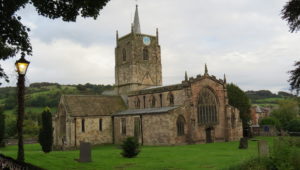
Copyright © Jane E. Wilcox, Forget-Me-Not Ancestry, Albany, NY www.4getmenotancestry.com.
In September 2017 I led a tour to Derbyshire, England, in search of my Puritan ancestors William Wilcockson and his wife Margaret. They came to New England on the Planter in 1635 with their two-year-old son John Wilcockson and Ann Harvie, whom I believe to be Margaret’s sister. They came during the Puritan Great Migration 1620-1640. With them on the Planter were Margaret’s first cousins Richard Harvie and his sister Mary Harvie with her husband William Beardsley and their three children Mary, John and infant Joseph. This homecoming trip with my cousins in 2017 culminated my research on the Wilcocksons of Biggin-by-Hulland, the Harvies of Ilkeston and their minister Rev. Adam Blakeman/Blackman (who founded Stratford, Conn. with them in 1639) that I undertook on three genealogy research trips to England between 2000 and 2015.
On this trip my cousins and I followed in the footsteps of Puritan William and Margaret Wilcockson (not spelled Wilcoxson as many have tried to modernize it) from their origins in Derbyshire, England, to their exposure to non-conformist ideas that eventually caused them to emigrate to America, to the churches they attended, to their dissenting Puritan network of family and friends, to their journey to the port of London to take passage on the Planter in 1635. While in England I sent daily emails to about 50 of my extended family and friends, as I had done in the past with the three other research trips, sharing our journey with them. The emails sent during the trip have been expanded and fact-checked to present here as blog posts. When you are reading my account of Puritan William in England, keep in mind that this is a proposed family of origin for William Wilcockson of Stratford, Conn. based on the evidence in the available records. Think “probable” and “probably” when you read Puritan William’s story.
Down the road I will write a series of articles giving the documentary evidence as to why I believe Puritan William was the son of tanner William Wilcockson and his first unknown wife from Biggin-by-Hulland, Derbyshire, and why Puritan William’s wife Margaret was Margaret Harvie, daughter of weaver James Harvie and his wife Elizabeth Winfield from Ilkeston Derbyshire — and not Margaret Birdseye or Birdsey as has long been erroneously held. These articles will contain more details and all of the sources I used to compile the evidence, as well as the genealogies of the Wilcockson, the Harvie and the Blakeman families in England in the 1500s and early 1600s.
Day 2
We had the perfect day.
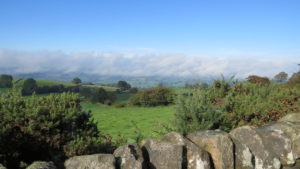 The view this morning driving from Spout Barn, our accommodations, to Wirksworth village was worth stopping the SUV in the middle of the one-lane road and everyone with a camera getting out of the car to take some photos. Luckily no other car wanted to go by. I got my driving-on-the-left-side-of-the road bearings back with some sleep (I was dead to the world for 9-1/2 hours last night) and drove today.
The view this morning driving from Spout Barn, our accommodations, to Wirksworth village was worth stopping the SUV in the middle of the one-lane road and everyone with a camera getting out of the car to take some photos. Luckily no other car wanted to go by. I got my driving-on-the-left-side-of-the road bearings back with some sleep (I was dead to the world for 9-1/2 hours last night) and drove today.
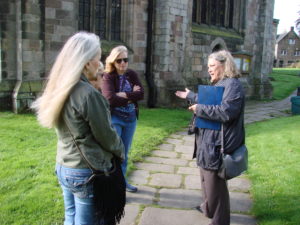
Photo by Chet Wilcox.
We started the day meeting our distant Wilcockson cousin Deborah Hart Stock at St Mary the Virgin church in Wirksworth. I first met Deborah somewhere online a few years ago, and then met her in person 2-1/2 years ago when I was last in England researching. She descends from Puritan William Wilcockson and Margaret Harvie through their daughter Sarah (Wilcockson) Meigs. My Wilcockson line also connects to the Meigs family in Guilford and Killingworth, Conn., so Deb and I are doubly and probably triply cousins. Deb drove from the London area to join us for two days. Her father was American and her mother was British.
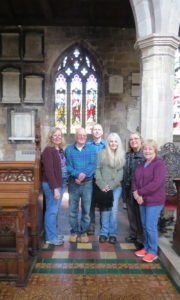
Jane, Chet, Barry, Marilyn, Deborah, and Pat at St Mary the Virgin church in Wirksworth, home parish of the Wilcocksons.
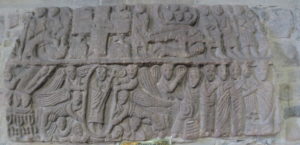
Lid of the sarcorphagus.
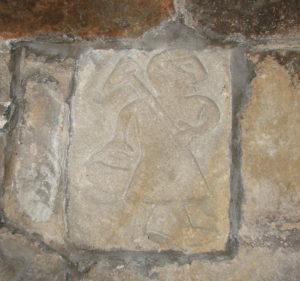
T’owd [The Old] Man, lead miner. Photo by Chet Wilcox.
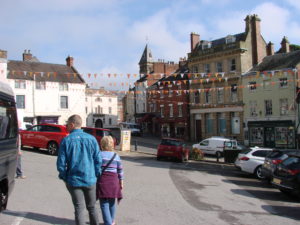 The village of Wirksworth was both a market town and a fair town in Puritan William Wilcockson’s day. Markets were held weekly and fairs were held quarterly. The former were for selling produce; the latter for trading livestock, finding employment and other more seasonal things. A town needed to get a royal charter to hold a fair. The Wilcocksons from Biggin probably would have come to Wirksworth for both the market and the fair, with tanner William likely selling some of his leather. Biggin is only 4 miles from Wirksworth.
The village of Wirksworth was both a market town and a fair town in Puritan William Wilcockson’s day. Markets were held weekly and fairs were held quarterly. The former were for selling produce; the latter for trading livestock, finding employment and other more seasonal things. A town needed to get a royal charter to hold a fair. The Wilcocksons from Biggin probably would have come to Wirksworth for both the market and the fair, with tanner William likely selling some of his leather. Biggin is only 4 miles from Wirksworth.
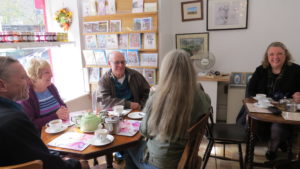
The Tea Room, Wirksworth.
For lunch we ate at the Tea Room. We collectively had corned beef hash, a sausage roll, quiche, and a tuna bap. A bap is a sandwich. We couldn’t leave without having scones with butter, and of course we had tea. The proprietors were a cute couple probably in their 80s.
After lunch Barry went off on his own to do a 5-mile hike around the perimeter of Wirksworth where he discovered Highland cows, lead and rock quarries, and Travelers a.k.a. gypsies.
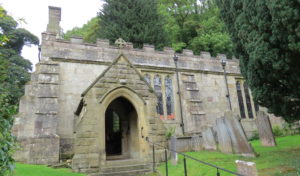
St Margaret’s chapelry, Carsington.
Carsington
The rest of us drove into the hills west of Wirksworth to Carsington where we visited St Margaret’s church, a very small chapelry where the Gell family worshipped. The Gells were the lords of the manor of Wirksworth and owned the land that the tenants, called copyholders, leased. Some of the Gells had their tombs and effigies at St Mary the Virgin church in Wirksworth. Wirksworth was also their home parish, but they had the chapelry built in Carsington so they wouldn’t have to travel so far. The Gell’s nearby manor house was closed for visitation today.
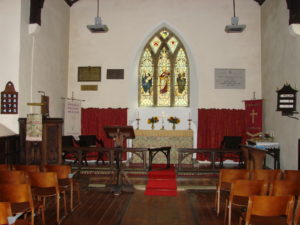
Photo by Chet Wilcox.
Speaking of the Gells owning the manor of Wirksworth: I didn’t mention how the manorial land holding system worked yesterday. My Wilcocksons were copyholders in the manor of Biggin. Copyholders leased their land from the lords of the manor. In the case of Biggin and other royal manors, the lords of the manor were the monarchs. As I mentioned yesterday, Biggin was a submanor of the manor of Duffield Fee, which was part of the Duchy of Lancaster. Biggin became a royal manor when the Lancasters became kings of England. Biggin manor is one jurisdiction where we find the Wilcocksons.
To complicate things even more, Biggin was also part of Hulland Ward, which was part of the royal forest called Duffield Frith (think Robin Hood and Sherwood Forest). The frith was another jurisdiction where we find the Wilcocksons. Between the manor and the forest juridictions, the Wilcocksons show up in two sets of court records regarding Biggin — the manorial court records for Duffield Fee where they were receiving and conveying copyhold land and paying their rents to the lords of the manor and the Duffield Frith court records where they were fined for cutting down the king’s trees and letting their pigs graze on the king’s land (called pannage). Tanner William’s father, Thomas, was fined for “falling” diverse oaks in the royal forest and then giving the wood to his son William in 1581 when Queen Elizabeth was monarch. The woodmote (forest) court record noted that Thomas of the manor of Biggin did this on a copyhold parcel called Riddings — which was the same parcel that tanner William received in 1577 and still held in 1611. (You can see how these named parcels of copyhold land help link generations.)
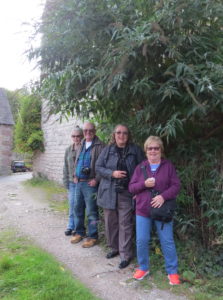
Taking refuge from the rain on our walk through Wirksworth.
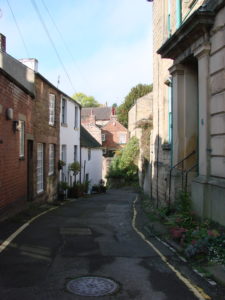
Photo by Chet Wilcox.
Wirksworth again
After Carsington, Pat, Marilyn, Chet, Deb and I then walked around the village of Wirksworth, and among other things discovered the Baptist cemetery. We explored narrow alleys and cobbled walkways until it was time for dinner. We saw the Barmote Court where the lead miners held their court. This court in Wirksworth is believed to be the oldest trade court jurisdiction in the world – established in the 13th century. See Barmote Court. Wirksworth had a huge lead mining industry at the time the Wilcocksons lived in the area, but there is no evidence that the Wilcocksons profited or worked in the mines.
On our walk through Wirksworth we saw the outline of a 15th century house, called the Cruck House, that is visible on the end of a new house. See photo below.
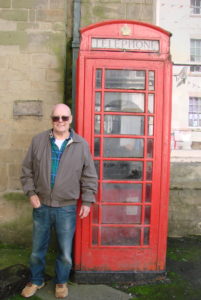 Later Barry found us back at St Mary the Virgin church. He had stopped at the Ale House after his hike. With only £3 and some odd change in his pocket, he put that on the counter and asked the bartender what he could get for that amount. The bartender said a pint of beer and Barry was happy. When he had finished his pint, Barry had to go find the banker of the group who had all our English money (that would be me) in order to ask for a fiver to go back and get another pint. After wandering a little more, we eventually found Barry back at the Ale House where he tried to ignore us when we poked our heads in the door and waved.
Later Barry found us back at St Mary the Virgin church. He had stopped at the Ale House after his hike. With only £3 and some odd change in his pocket, he put that on the counter and asked the bartender what he could get for that amount. The bartender said a pint of beer and Barry was happy. When he had finished his pint, Barry had to go find the banker of the group who had all our English money (that would be me) in order to ask for a fiver to go back and get another pint. After wandering a little more, we eventually found Barry back at the Ale House where he tried to ignore us when we poked our heads in the door and waved.
We had dinner at Le Mistral, an obviously French restaurant with wonderful food and
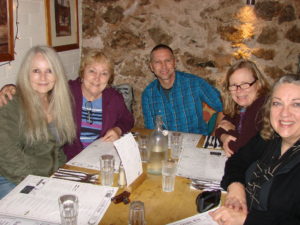
Le Mistral, Wirksworth. Photo by Chet Wilcox.
desserts. My entre was a wonderful beef bourguignon. The restaurant has tables in the basement, so we ate surrounded by stone block walls in a small room. We laughed and laughed and laughed through all courses of the meal — so loudly that we figured our neighbors at the table next to us would think us loud Americans — eventhough one of us was a Brit (with some American roots). We laughed a lot today.
It was a delightful day, and we’re looking forward to tomorrow’s day trip.
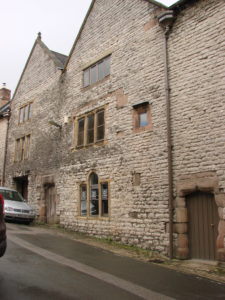
Oldest building in Wirksworth. Photo by Chet Wilcox.
Chee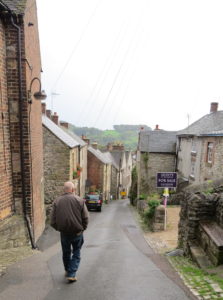 rs!
rs!
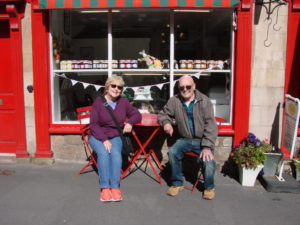
Outside the Tea Room.
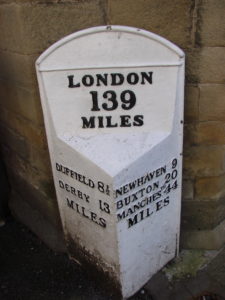
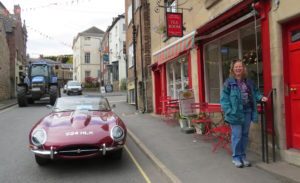
My carriage awaits me outside the Tea Room. Is it the car or the tractor?
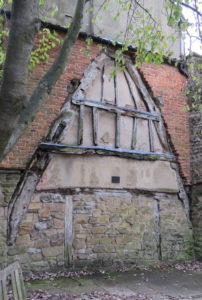
Outline of 15th century house in Wirksworth.

2 thoughts on “The Grand Wilcockson Tour to Derbyshire Day 2: Wirksworth and Carsington”